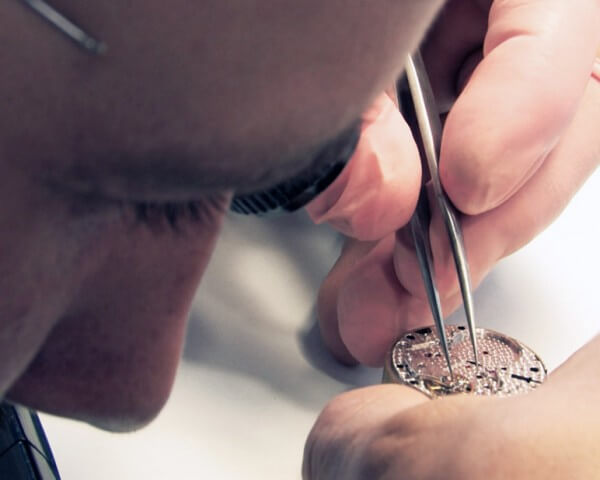Did you know watchmakers use many different lubricants, each with its own characteristics? That every component requires a specific oil or grease (not the same thing) depending on its function and location? That oils and greases are classified according to their viscosity, texture and colour? Could you deposit the precise amount of oil needed on the pallet stones? Of course, only a professional watchmaker can answer yes to all these questions, and more. A quality watch is a work of art to be admired for its beauty, its more or less complicated functions, and the complexity of its design, assembly and workings. Little short of miraculous! However, for these elements to form a harmonious whole for years to come, a watch needs regular servicing. Why then do we willingly service our cars, which have a limited lifespan, yet still seem reluctant to take care of a watch that will be handed down from generation to generation?
Sixty centres worldwide
“If we were to compare maintenance of a car and a watch, we would see that a car has a useful lifespan of 4,300 hours or 300,000 kilometres, and that a watch has a useful lifespan of at least one generation, equivalent to 70 years or 613,000 hours,” observes John Vergotti, managing director of Patek Philippe España and the man behind the service centre which the brand opened there this year. “A car needs an annual service whereas a watch requires servicing every three to five years. This means that in ten years, a car will have been serviced ten times at an approximate cost of €8,000 whereas a watch will have been serviced twice, at a cost of around €880 for a model with a basic mechanical movement.”
Well aware how important these elements are, and never forgetting that its timepieces are handed down between generations, Patek Philippe has an International Customer Service division with 60 centres spread throughout the world. They employ more than 200 qualified watchmakers who repair, restore and service at least 40,000 watches a year. One of these centres is on the top floor of the brand’s magnificent building in the centre of Barcelona. Daylight pours in, giving the impression of an authentic Swiss workshop, and while the windows may not look onto mountains and trees, the view of the city’s rooftops is equally stunning. To complete the picture, all the furniture, equipment and decoration has been brought from Switzerland.
Four levels of qualification
The Barcelona service centre employs four watchmakers with different degrees of training and specialisation, all of which meet the brand’s criteria. Each year, over 200 people, including 80 watchmakers, are trained at Patek Philippe’s head office in Plan-les-Ouates, near Geneva. This goes from basic initiation to information on the products’ characteristics or more specific quality criteria. Ongoing training ensures watchmakers master the new technologies that can apply to more complex timepieces.
Watchmakers follow four levels of training:
- Quick Service corresponding to basic training for watchmakers at points of sale
- Level 2 which deals with simple quartz and mechanical movements
- Level 3 which deals with complex movements
- Advanced or maximum specialisation, an obligatory level for watchmakers working on grandes complications
The team at work in Barcelona has been trained to the highest standard, and can therefore service any of the brand’s contemporary watches (from 1971 to today) and restore historic pieces (from 1839 to 1970). This summer, Ramón Vilar, one of the four watchmakers at the Barcelona centre which he also directs, completed advanced level training in Switzerland. Francisco Javier Jané, the longest-serving member of the team who has been with Patek Philippe for more than 35 years, has also trained to the highest level. The third watchmaker, Juan González, has trained to level three and can pride himself on almost 40 years’ experience. Their youngest colleague, Jérémie Deumetier, lured from his native Switzerland by Mediterranean sunshine and light, holds level two. They each have complete responsibility for every timepiece entrusted to them: whatever work is required, a watch will be in the hands of one of these professionals only. “They each have the skills to repair and even restore a watch. They also know how to make the parts required to do so, such as the screws,” John Vergotti says with pride.

Between six and eight weeks
Question: what happens to a watch when it reaches the Patek Philippe service centre? John Vergotti explains: “First we create a file. We scan the watch and search our archives for any previous records. We then analyse what needs to be done and draw up a price quote for the customer.” Only when this quote has been accepted can work truly begin for the watchmaker, who nurtures a true passion for his job. Once the watch has been appraised and the situation fully assessed, “we take the movement apart, inspect and clean the components, and replace any which are defective or worn. We then reassemble, lubricate and adjust the parts,” says Ramón Vilar.
Whether repairing, restoring or simply adjusting a mechanism for optimal efficiency, and having carried out an inspection in strict compliance with specifications drawn up by Patek Philippe in Geneva, “we clean and polish the case, buckle and strap. We then fit the movement in the case, test the water-resistance and carry out a final inspection to ensure a flawless appearance. Depending how complex the movement is, a full service can take between six and eight weeks,” concludes Ramón Vilar, who never forgets that the functioning of the watches that pass through his hands – watches whose monetary and historic value is often beyond calculation – depends on his skill and knowledge.















